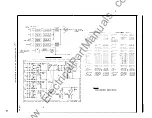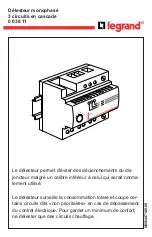
relay pickup (3 to 5 ms) and operate time of the
ojc unit (3 to 8 ms).
The range of adjustment is a m inimum of 1 00
ms ( 1 50 to 250 ms).
The control timer must be set at least 1 6 ms
longer than the breaker failure timer. The control
timer acts essentially as a pulse stretcher on the
B FI input and then resets. Since the overcurrent
unit never picks up on successful clearing, it can
not be used as a cutoff for the breaker failure
timer.
BF
T I M E R
A calibrated scale located o n the front o f the
timer module permits setting the time delay from
1 8 to 1 75 milliseconds. The scale is calibrated in 25
ms increments. If more accurate settings are
desired an oscilloscope or electronic timer may be
connected between the upper red test jack on the
timer module and terminal 8 of the relay (Com
mon N egative). Jumpering test point TP6 and TP7
on the timer module prevents the control timer
from resetting the B F timer and will help in set
ting the B F timer. Remember that if the control
timer is set shorter than the B F timer, the B F timer
will not be able to operate the reed relay (RR).
A locking tab is provided to hold the B F timer
setting from being accidentally changed.
The breaker failure timer should be set to ex
ceed the breaker normal clearing time by an ap
propriate margin. Where the breaker contains a
resistor that is inserted on tripping and the over
current fault detectors are set below the resistor
current, the additional time for this interruption
must be included. A secure margin for the SBF- 1
is 2 cycles. (33 ms)
I N D I CATI NG CONTACTOR
SWITC H (I CS)
Connect the lead located in front of the tap
block to the desired setting by means of the con
necting screw.
When the relay energizes a 1 25 or 250 Vdc type
WL relay switch or equivalent use the 0.2 amp tap.
For 48 Vdc applications set the unit in the 2 amp
I.L. 41-776.5
t a p a n d u s e a t y p e WL r e l a y w i t h a
S#304C209G0 1 coil or equivalent.
I N STALLATIO N
The relays should be mounted on switchboard
panels or their equivalent in a location free from
dirt, moistu,re, excessive vibration and heat.
Mount the relay vertically by means of the rear
mounting stud or studs for the type FT projection
case or by means of the four mounting holes on the
flange for the semi-flush type FT case. Either the
stud or the mounting screws may be utilized for
grounding the relay. External toothed washers are
provided for use in the locations shown on the out
line and drilling plan to facilitate making a good
electrical connection between the relay case, its
mounting screws or studs, and the relay panel.
Ground wires are affixed to the mounting screws
or studs as required for poorly grounded or in
sulating panels. Other electrical connections may
be made directly to the terminals by means of
screws for steel panel mounting or to the terminal
stud furnished with the relay for thick panel moun
ting. The terminal stud may be easily removed or
inserted by locking two nuts on the stud and then
turning the proper nut with a wrench.
For detail information on the FT case refer to
I.L. 4 1 -076.
ADJU STMENTS A N D
M AI NTENANCE
The proper adjustment to insure correct
operation of this relay have been made at the fac
tory and should not be disturbed.
Routine Test
The following check is recommended to insure
that the relay is in proper working order. Refer to
Fig. 1 0 for test connections.
Overcurrent Detector
Check for correct scale marking by placing all
the tap settings in the 0.5 Amp. position and rotate
the Phase and Ground tap multiplier knob (on the
overcurrent unit knob) to the X 1 calibration mark.
Jumper test point TP 6 and TP7 on the timer
5
www
. ElectricalPartManuals
. com






































